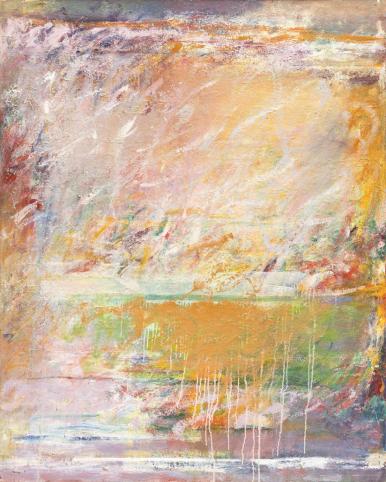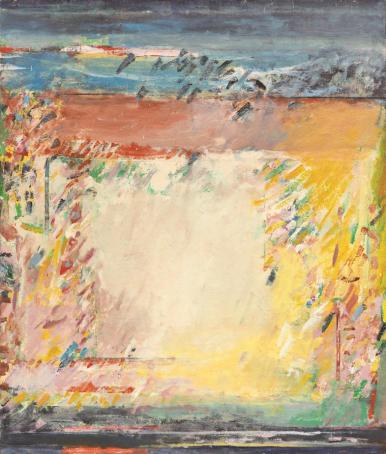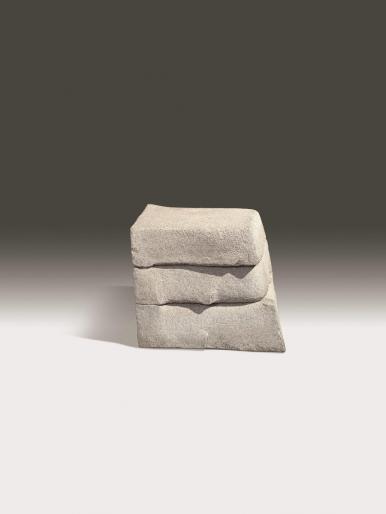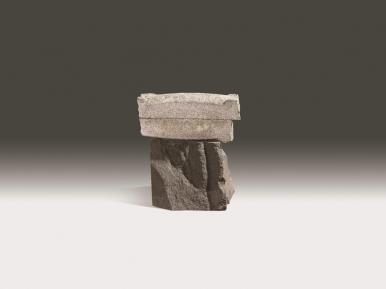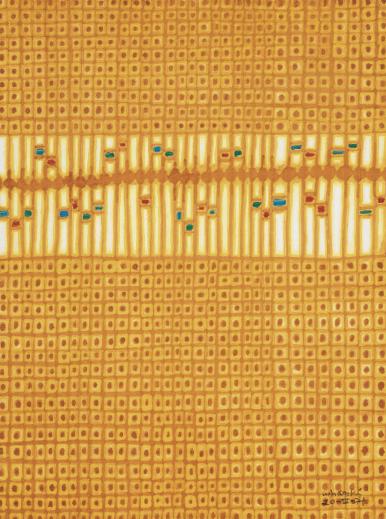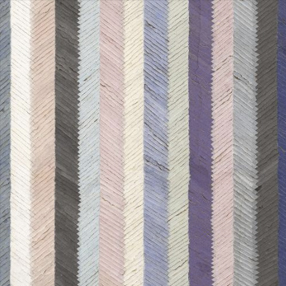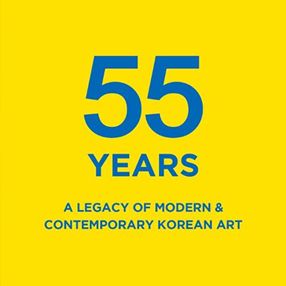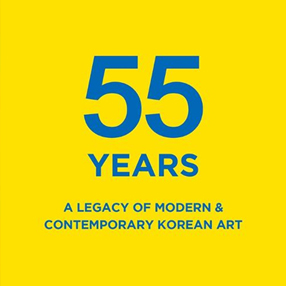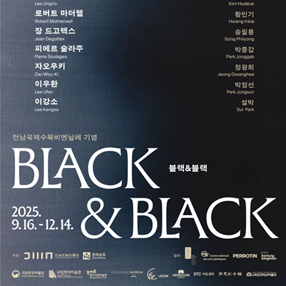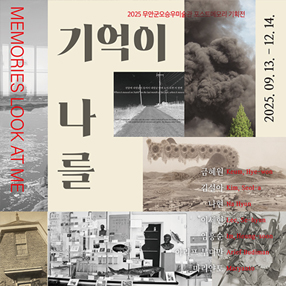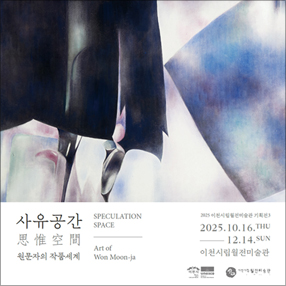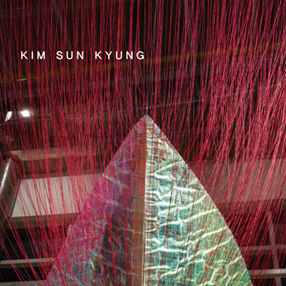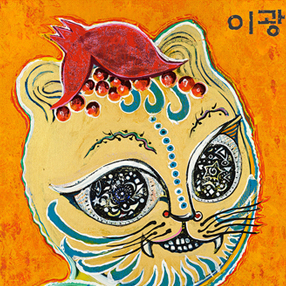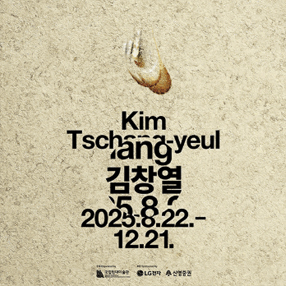본문
-
한용진ㆍ문미애
Untitled, 1980s, Oil on canvas, 153 x 122cm ⓒMoon & Han
-
한용진ㆍ문미애
Untitled, 1980s, Oil on canvas, 162.8 x 137.5cm ⓒMoon & Han
-
한용진ㆍ문미애
Untitled, 1980, Granite, 53 x 50.5 x 38(h)cm ⓒMoon & Han
-
한용진ㆍ문미애
Untitled, 1985, Granite and blue stone, Top 61 x 15 x 28(h)cm, Bottom 46 x 40 x 34(h)cm ⓒMoon & Han
-
김환기
Untitled 28-IV-71, 1971, Oil on paper, 62 x 45cm ⓒWhanki Foundation · Whanki Museum
-
김환기
Untitled 20-III-71, 1971, Oil on paper, 55.5 x 41cm ⓒWhanki Foundation · Whanki Museum
-
Press Release
1963년 상파울루비엔날레를 거쳐 뉴욕에 정착한 김환기(1913-1974)에게 타향에서 만나 가족 이상의 애정을 나누던 존재가 있었다. 그들은 한용진(1934-2019)과 문미애(1937-2004) 작가이다. 한용진, 문미애 작가는 서울대 미대 선후배로 만나 1962년 부부의 연을 맺은 작가 부부다. 그들은 1964년 처음 뉴욕을 경험하고 돌아간 뒤, 한국에서의 보장된 미래를 뒤로하고 67년 본격적으로 뉴욕에 정착해 작품 활동에 매진하였다.
김환기, 한용진의 인연은 한용진이 경기고 3학년이던 때에 홍익대학교가 주최한 <국제학생미술대회>에서 입상하면서 시작되었다. 당시 홍익대학교 미술대학 교수로 재직중이던 김환기가 한용진에게 상을 수여하였다. 이후, 1963년 《제7회 상파울루비엔날레》에 김환기와 한용진이 함께 참여하게 되면서 그 인연을 이어가게 된다. 김환기는 《제7회 상파울루비엔날레》에 대표 작가로서 <섬의 달밤>(1959)등 3점의 회화를 출품하였고, 한용진은 당시 주철조각 <무제>(1963)를 출품하였다. 이 비엔날레 참여를 계기로 김환기는 1963년 10월 20일, 현대미술의 요람 뉴욕에 정착하게 되었고, 한용진은 1964년 국제교육재단(IIE: Institute of International Education)의 초청으로 미국으로 건너가면서 김환기, 김향안 부부의 예술 여정에 한용진, 문미애 부부가 함께 동행하였다. 이들은 각별한 사이로 뉴욕에서 동고동락하며 작품활동을 이어갔고, 서로 힘이 들 때 위로가 되고 지원하는 사이가 되었다.
갤러리현대는 뉴욕에서 활동 중이던 문미애 작가의 초대전을 1984년과 88년에 두 차례 개최하였고, 1994년에는 한용진 작가의 초대전을 개최하였다. 특히 문미애 작가의 두 차례 국내 개인전은 그가 2004년 작고하면서, 그의 생존 시기에 그의 섬세하고 깊이 있는 색조와 공간 세계를 한국 미술계에 소개한 유일한 전시가 되었다.
전시장의 1층에는 문미애와 한용진의 작품이 함께 전시된다. 이번에 전시되는 문미애의 작품들은 1970년대부터 1990년대에 제작된 것들이다. 문미애는 깊은 색감과 터치로 앵포르멜 운동에 동참하던 자유 정신에 입각하여 평생 일관된 작업을 했다. 화면을 나눈 면에 과감한 붓 터치로 색면을 채워 넣은 <무제>(1980년대), 수직, 수평의 화면 분할을 중첩시켜 마치 사각형을 반복한 바탕에 물감의 중첩으로 탁하고 깊어진 색채를 채워 나간 <무제>(1980년대) 등 자유로움과 절제가 동시에 나타나 전체적으로 균형 있는 화면을 이루는 작업들이 전시되었다. 함께 전시되는 한국 추상 조각 1세대 한용진의 작업은 돌을 깎아 일정한 형태를 만들기보다 돌 자체의 재질과 형태를 존중하여 최소한의 손길로 다듬어낸 작품들이다. 이러한 제작방식을 고수하는 한용진의 그의 작품은 다소 거칠고 투박하며, 인위적으로 조각하기보다 세월의 흐름에 따라 자연스럽게 형성된 느낌을 준다. 우직한 돌 조각에서 올곧은 작가의 삶이 드러난다. 그는 2011년부터 제주도를 오가며 제주의 현무암으로 작품을 제작하여 재료의 한계를 뛰어넘는 도전정신을 보이기도 했다. 단순한 형태의 간결한 미감이 돋보이는 한용진의 조각은 과감한 생략과 강조로 오히려 보는 이의 상상력을 자극하며, 단순함에 깃든 삶의 지혜를 전하고 있다.
"봄내 신문지에 그리던 중에서 나는 나를 발견한다. 내 재산은 오직 '자신(自身)'뿐이었으나 갈수록 막막한 고생이었다. 이제 이 자신이 똑바로 섰다. 한눈 팔지 말고 나는 내 일을 밀고 나가자. 그 길밖에 없다. 이 순간부터 막막한 생각이 무너지고 진실로 희망으로 가득차다."
– 1967년 10월 13일 김환기의 일기.
전시장의 2층에는 김환기의 뉴욕시대 작품들이 전시되어있다. “뉴욕시대”라고 일컬어지는 1963년부터 1974년의 시기에 김환기는 순수 추상의 세계에 빠져들었다. 김환기 말년 화풍을 대표하는 전면점화가 이 시기에 탄생했다. 이는 김환기의 숱한 실험과 고민의 결과였고, 김환기의 조형적, 그가 종이 작업, 신문지, 한지 등으로 작업한 재료적인 시도에서도 알 수 있다. 김환기는 종이를 이용해 공간을 탐구하는 장으로 삼았고, 섬세한 점과 선, 면을 통해서 그만의 개성적인 방법으로 조형 공간을 다양하게 해석해냈다. 김환기는 종이가 머금은 맑고 투명한 액체가 화면에서 서서히 새나오거나 뿜어 나오는 듯한 느낌을 즐겼다. 그는 이후 캔버스 작업에서도 그 느낌을 유지했다.
이번 전시 《김환기 뉴욕시대와 한용진, 문미애》는 60~70년대 뉴욕이란 머나먼 이국에서 예술가로서의 고독과 외로움을 이겨내고, 그 힘을 예술로 승화시킬 수 있도록 서로 큰 힘이 되어 준 김환기, 한용진, 문미애 작가의 우의(友誼)를 기념하기 위해 마련되었다. 서로를 응원하며 각자의 예술을 발현한 김환기, 한용진, 문미애 작가의 각각 15점씩 총 45점이 소개된다.
Settling in New York in the wake of the 1963 São Paulo Biennale, Kim Whanki (1913–1974) encountered two people who would become like a new family to him: Han Yong Jin (1934–2019) and Moon Mi Aie (1937–2004). Han and Moon were artists who had met as students at the Seoul National University art college and eventually married in 1962. They had experienced a taste of life in New York in 1964 before returning home to Korea, but eventually gave up their secure future in their homeland and committed themselves to returning to New York in 1967 and devoting themselves to artistic work there.
The connection between Kim Whanki and Han Yong Jin dated back to Han’s third year at Kyunggi High School, when he was awarded a prize at an international students’ art competition organized by Hongik University. As a professor at the university’s college of art at the time, Kim was the one who presented Han with his award. Their connection would continue in 1963 when they both took part in the 7th São Paulo Biennial. Kim was a representative artist there, presenting three paintings including Moon Night of Island (1959), while Han showed his cast iron sculpture Untitled (1963). After that biennial, Kim would move to the contemporary art hotbed of New York on October 20, 1963. Meanwhile, Han would move to the United States in 1964 at the invitation of the Institute of International Education (IIE), which led to him and wife Moon Mi Aie joining Kim and his wife Kim Hyang-an on their artistic journey. The two couples were very close, sharing the joys and travails of living and working in New York while serving as sources of comfort and support to each other when times were tough.
In 1984 and 1988, Gallery Hyundai held two invitational exhibitions presenting the work of Moon Mi Aie, who was then based in New York; it organized another for Han in 1994. At the time that Moon passed away in 2004, her two solo exhibitions there had been the only ones to share the delicate, deep tones and spaces of her work with the Korean art world during her lifetime.
The gallery’s first floor shows both Moon and Han’s work together. The work by Moon presented here was produced between the 1970s and 1990s. She adopted a consistent approach to her work throughout her lifetime, her deep color sense and touch reflecting the free spirit she showed as a member of the Informel movement. The images featured here boast balanced canvases combining freedom with restraint, including one Untitled work (1980s) in which she applies bold brushstrokes to fill in color planes on a segmented canvas, and another Untitled work (1980s) in which she juxtaposes vertical and horizontal partitions to form a background of repeated rectangles, which she fills with thick, deep colors through multiple layers of paint. Exhibited alongside her work are pieces by Han, a member of the first generation of Korean abstract sculptors. Rather than shaping stone to create defined forms, Han’s approach involved a minimal application of the artist’s hand and a respect for the stone’s original quality and form. Adhering to this approach, Han produced artwork that was somewhat crude and coarse, conveying the sense of having been naturally formed over years rather than artificially sculpted. In the simple stone sculptures, we see aspects of the artist’s honest approach to life. Han displayed an adventurous approach transcending the limits of materials, as when he began a project in 2011 of traveling back and forth between the mainland and Jeju to produce artwork with the island’s basalt. Distinguished by their concise aesthetic of simple forms, Han Yong Jin’s sculptures stimulate the viewer’s imagination with their bold omissions and emphases, expressing the wisdom of life to be found within “simple” things.
"During the spring, I had been drawing on newsprint when I found myself. My only asset was myself, and things had been looking increasingly bleak. At that point, this self of mine stood itself up. I had no choice—I had to forge ahead with what I was doing and not allow myself to get sidetracked. At that moment, all those feelings of uncertainty crumbled away, and I was filled with truth and hope.” — Kim Whanki’s journal, October 13, 1967
The second floor of the gallery shows work from Kim Whanki’s “New York period.” This period from 1963 to 1974 was when Kim immersed himself in a world of pure abstraction. It also saw the emergence of the style that would define his later painting: complete pointillism. The outcome of endless experimentation and wrestling by the artist, it can also be observed in his aesthetic explorations of ordinary paper, newsprint, Korean hanji paper, and other materials. Kim treated paper as a basis for exploring space, interpreting aesthetic environments in diverse, idiosyncratic ways through his delicately judged points, lines, and planes. He enjoyed the feeling of the pure, transparent moisture within the paper seemingly spilling or billowing out from the canvas—a quality that he would retain in his later canvas-based work.
The exhibition Kim Whanki’s New York Period, Han Yong Jin, and Moon Mi Aie was organized to commemorate the friendship among three artists who served as sources of strength to each other, overcoming all the loneliness and solitude of life as an artist in faraway New York during the 1960s and 1970s and channeling that power into art. It features a total of 45 works—15 each by Kim Whanki, Han Yong Jin, and Moon Mi Aie, three artists who each achieved their own art even as they gave strength to one another.전시제목김환기 뉴욕시대와 한용진ㆍ문미애
전시기간2022.06.02(목) - 2022.06.30(목)
참여작가 김환기, 한용진ㆍ문미애
관람시간10:00am - 06:00pm
휴관일월요일
장르회화, 조각
관람료무료
장소갤러리현대 GALLERY HYUNDAI (서울 종로구 삼청로 14-6 (사간동) )
연락처02.2287.3500
-
Artists in This Show
-
1913년 전남 신안출생
-
갤러리현대(GALLERY HYUNDAI) Shows on Mu:umView All
Current Shows
-
BLACK & BLACK
전남도립미술관
2025.09.16 ~ 2025.12.14
-
기억이 나를 본다
무안군오승우미술관
2025.09.13 ~ 2025.12.14
-
원문자: 사유공간 思惟空間
이천시립월전미술관
2025.10.16 ~ 2025.12.14
-
유리상자-아트스타Ⅲ 김선경 [無와 有의 경계에서]
봉산문화회관
2025.09.12 ~ 2025.12.14
-
먼지를 걷는 자들 Dust Walkers
신한갤러리
2025.11.13 ~ 2025.12.20
-
유리: 투명한 고리
갤러리 학고재
2025.11.19 ~ 2025.12.20
-
이광 개인전 《우주호랑이- 호랑이 여자로 산다는 것은》
갤러리 마리
2025.11.21 ~ 2025.12.20
-
김창열
국립현대미술관
2025.08.22 ~ 2025.12.21




